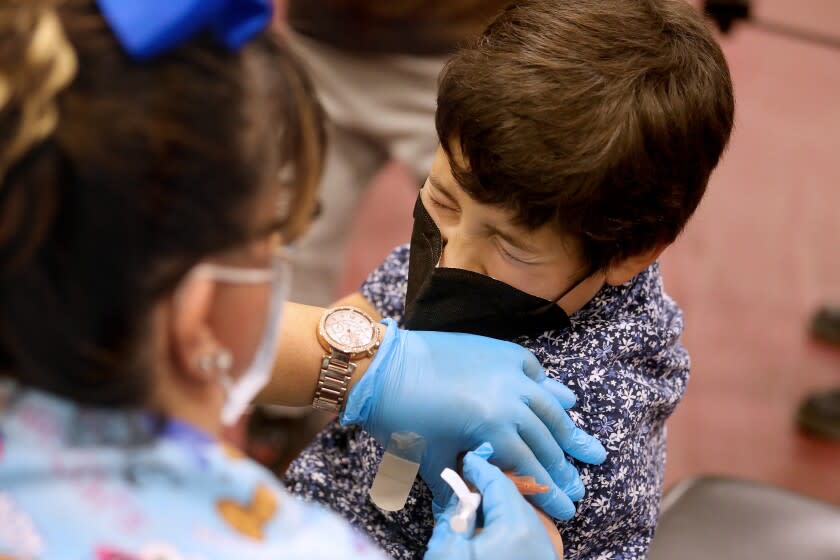Editorial: California's schools don't need a vaccine mandate — at least, not right now

- Oops!Something went wrong.Please try again later.
Though experts’ understanding of COVID-19 has grown tremendously, the virus that causes it is an ever-changing story, challenging our ability to form policy that works from one season to the next.
In January, when state Sen. Richard Pan (D-Sacramento) introduced a bill to make COVID-19 vaccination mandatory for K-12 students, fears about the easily transmissible Omicron variant were at a high point. But months later, a vaccine mandate for school-age children seems less urgent — at least for the moment.
California schools are operating safely; children are less likely to develop serious cases of COVID-19; and the vaccine is still being given under emergency use authorization for kids 5 to 15, rather than under final approval, as the U.S. Food and Drug Administration considers more data. And there's still debate about how effective vaccines are at stopping infections among children. A large, but not yet peer-reviewed, study conducted by the New York State Department of Health found that, in the lower dose given to children ages 5 to 11, protection from infection dropped from 68% to 12% within about a month. Still, CDC data show that the vaccine offers protection for those children against serious illness at a higher rate and for longer.
While this situation could change drastically with infection rates again increasing because of a new subvariant, Pan made a sensible move earlier this month to hold off on his vaccine mandate bill. Gov. Gavin Newsom also postponed a requirement that students be immunized against COVID-19 before the start of the next school year.
To be clear, it is still important to vaccinate children and we strongly urge parents to ensure their children get the jab if eligible. Serious illness happens among younger people and there also are risks of long COVID or related long-term health problems.
Preventing serious disease is still the main intent of vaccination, and the jabs do this for children just as well as they do for adults. Unvaccinated children ages 5 to 11 are twice as likely to be hospitalized as their peers who have been inoculated, the Centers for Disease Control and Prevention found in a review of cases during the winter’s Omicron surge. Health and education officials should continue to reach out to families to overcome fears and dispel myths about vaccination.
Pan says he’s putting off the bill in order to provide better access to vaccination; parents have said it’s too hard to take off work to bring their children to vaccination clinics. But that sounds like only part of the problem. In Los Angeles County, where L.A. Unified schools offered extraordinary access to vaccination for students and families, 31% of 5- to 11-year-olds are fully vaccinated, slightly lower than the statewide number. In contrast, 77% of kids 12 to 17 in L.A. County are vaccinated; parents obviously found it easy enough to get older children to a vaccination clinic.
The much likelier explanation is that parents think the lower rates of serious illness among kids, especially elementary school age kids, means that the disease is less of a threat than these relatively new vaccines, about which they’re hearing a lot of misinformation.
Given the resistance among many parents to inoculating their children as well as the legal iffiness of mandating an emergency-use vaccine, Pan’s bill already faced a fraught future.
And right now, the bigger threat to kids’ well-being is chronic absenteeism, which harms their emotional health and academic progress. The best thing for most students is to be in school and in a physical classroom; that’s especially true for students who depend on school for nutritious meals, physical activity and at least some counseling. A vaccine mandate could drive many of them away from in-person learning.
As the world has seen several times in the last two years, COVID-19 can turn on a dime. An even more transmissible and possibly far more dangerous variant could be in our future, putting new stress on hospitals. New vaccines might quell infection rates more effectively and for longer, and the existing ones are likely to receive final FDA approval for use in school-age kids in coming months.
At some point, a vaccine mandate might become the best policy, even a necessary policy. But for now, let’s focus on keeping kids in school.
This story originally appeared in Los Angeles Times.

